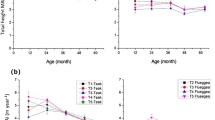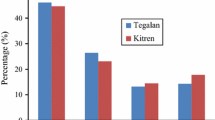Abstract
Growth, wood quality parameters and productivity estimations of 12-year-old teak (Tectona grandis L.f.) grown under three agroforestry systems, namely unmanaged block (Bum), unmanaged line on the farm boundary (Lum) and intensively managed block (Bim) plantations are studied. Mean annual increment (MAI) of 0.020, 0.006 and 0.016 m3 tree−1 year−1 was recorded in Lum, Bum and Bim, respectively. Overall growth performance of teak raised in Lum, plantation appears to be better than two block plantations (Bum and Bim). For evaluating various wood quality parameters, tree logs from each plantation were tested for different physical and mechanical properties according to the standard procedures. The wood quality of Bum was found to be comparatively superior to Bim and much better than those of Lum. The 12-year-old farm teak trees from three systems exhibited lower average values of different wood quality parameters compared to mature forest teak. Since physical and strength properties of Bum were inferior compared to Lum and Bim, its exploitation is not advisable at this stage. Line plantation, however, releases land for cultivation of arable crops and does not demand any special silvicultural management as required by Bim. Although, total extractable volume of teak wood available after 12-years of age from Bum was much smaller compared to Bim or Lum, its commercial exploitation at an early age may be preferred over other two practices due to better wood quality and lower management cost. For optimum economic utilization and mechanical maturity of wood, harvesting of block plantation may be delayed for about 10-15 years because growth volume and strength properties are expected to improve with age of tree.


Similar content being viewed by others
References
Agarwal PK, Khali DP, Sarma CR, Rangaswamy SR (1997) Establishment of agroforestry demonstration plantations in selected villages in Karnataka and Andhra Pradesh. MyFor 33(4):607–613
Agbontalor EA (2008) Influence of specific gravity on wood species selection for agroforestry in some Local Government Areas of Oyo State. Nigeria. African Journal of Agricultural Research 3(2):134–139
Anon (1986) IS: 1708. Specification for methods of testing small clear specimens. Bureau of Indian Standards, New Delhi
Anon (2013) WWF India—Timber trade. Available at http://www.wwfindia.org/about-wwf/enablers/forests/ttrade. Accessed 26 Dec 2013
Anon, Anon (1990) IS: 2455. Specification for methods of sampling of model trees and logs and their conversion for timber testing. Bureau of Indian Standards, New Delhi
Art HW, Marks PL (1971) A summary table of biomass and net annual primary production in forest ecosystems of the world. University of Maine, Maine, USA, Forest Biomass studies
Ball JB, Pandey D, Hirai S (2000) Global overview of teak plantations. In: Regional Seminar on Site, Technology and Productivity of teak plantations. Chiang Mai, Thailand, 26–29 January 1999. p. 11–34
Bhat KM (1999) Is fast growing teak inferior in wood quality? Wood News 10(1):48–49
Bhat KM, Gnanaharan R (2007) Processing and marketing of teak wood products of planted forests. Regional Workshop, 25–28 September, Kerala Forest Research Institute, Peechi, Kerala
Bhat KM, Hwan OM (2004) Teak growers unite. Trop For Update 14(1):3–5
Bhat KM, Indira EP (1997) Effects of faster growth on timber quality of teak. KFRI Research Report 132. Kerala Forest Research Institute, Peechi, Kerala (India) p 60
Bhat KM, Priya PB, Rugmini P (2001) Characterization of juvenile wood in teak. Wood Sci Technol 34:517–532
Centeno JC (2011) The management of teak plantations. Published at Treemail website. http://www.treemail.nl/teakscan.dal/files/mngteak.html. Accessed 9 Dec 2011
Chaturvedi AN, Khanna LS (1982) Forest mensuration. International Book Distributers, Dehra Dun 406
FAO (2000) Global forest resources assessment 2000. For Paper 140:23–38
Friday JB, Cabal C, Yanagida J (2000) Financial analysis of tree farming in Hawaii. Research Management. RM9, CTAHR Publication, University of Hawaii, Manoa
George M, Viswanath S (2000) Development of agroforestry models for different eco-climatic zones. NABARD Final Report, Institute of Forest Genetics and Tree Breeding, Coimbatore
George M, George M, Bhuvaneswaran C (2001) Productivity and nutrient cycling in teak plantations. In: Mandal AK, Ansari SA (eds) Genetics and Silviculture of Teak. International Book Distributers, Dehra Dun, pp 73–81
Mandal AK, Chawhan P (2003) Investigations on inheritance of growth and wood properties and their relationship in teak. Presented in ITTO-KFRI International Conference on Quality Timber from Sustainable Forest Management, 2–3 Dec., Kerala Forest Research Institute, Peechi, Kerala
Nair PKR (1993) An introduction to agroforestry. Kluwer Academic Publishers, London
Pandey D (2009) Teak plantations in the world and their productivity. International Workshop on Production and Marketing of Teakwood: Future Scenarios; 23-25 November, 2009 organized by Kerala Forest Research Institute, Peechi, Kerala, India. http://www.teaknet.org/node/5292 Accessed 26 Dec 2013
Pandey D, Brown C (2000) Teak: a global overview. Unasylva 201(51):3–13
Perez Cordero LD, Kanninen M (2003a) Heartwood, sapwood and bark content, and wood dry density of young and mature teak (Tectona grandis) trees grown in Costa Rica. Silva Fenn 37(1):45–54
Perez Cordero LD, Kanninen M (2003b) Heartwood, sapwood, bark content and wood dry density of young and mature teak (Tectona grandis) trees grown in Costa Rica. Silva Fenn 37(1):45–54
Purkayastha SK, Satyamurthi KR (1975) Relative importance of locality and seed origins in determining wood quality in teak. Indian For 101(10):606–607
Purushothaman S (2005) Land use strategies for tribals: a socio-economic analysis. Econ Polit Wkl 40:5611–5619
Rajput SS, Gulati AS (1993) Some considerations on the selection of reference timber for comparison in the evaluation of suitability indices of Indian timbers. J Ind Acad Wood Sci 14(2):96–102
Sekhar AC, Rawat BS (1966) Physical and mechanical properties of teak from different locations in India and neighboring areas. Indian For Rec Timber Mech 1(13):197–212
Shanavas A, Kumar BM (2006) Physical and mechanical properties of three agroforestry tree species from Kerala, India. J Trop Agric 44:23–30
Shukla NK, Lal M (1994) Physical and mechanical properties of plantation grown Tectona grandis (teak) from Mizoram. J Timb Dev Assoc (India) XL (3):38–49
Tee B (1995) Teak in Sabah. A sustainable agroforestry—the Haris Salleh experience. Kota Kinabalu, Malaysia, Sejati Sdn Bhd
Tewari DN (1992) A monograph on teak. International Book Distributors, Dehra Dun, p 479
Thulasidas PK, Bhat KM (2009) Log characteristics and sawn timber recovery of home-garden teak from wet and dry localities of Kerala, India. Small-scale For 8:15–24
Thulasidas PK, Bhat KM (2012) Mechanical properties and wood structure characteristics of 35-year-old home-garden teak from wet and dry localities of Kerala, India in comparison with plantation teak. J Ind Acad Wood Sci 9(1):23–32
Walker JCF (2006) Primary wood processing: principles and practice, 2nd edn. Springer, Heidelberg, p 596
Zobel B, Talbert J (1984) Applied forest tree improvement. John Wiley and Sons, New York, p 505
Acknowledgments
Authors would like to acknowledge the Director, Group Coordinator (Research) and the Head, Wood Properties and Uses, and Head, Tree Improvement and Propagation Divisions for their continuous encouragement and support during completion of the study. Authors would also like to thank the teak farmers of Devanahally taluk and the Managing Director, M/s Malu Plantations, Devanahally for their co-operation and support.
Author information
Authors and Affiliations
Corresponding author
Rights and permissions
About this article
Cite this article
Shukla, S.R., Viswanath, S. Comparative study on growth, wood quality and financial returns of teak (Tectona grandis L.f.) managed under three different agroforestry practices. Agroforest Syst 88, 331–341 (2014). https://doi.org/10.1007/s10457-014-9686-5
Received:
Accepted:
Published:
Issue Date:
DOI: https://doi.org/10.1007/s10457-014-9686-5




